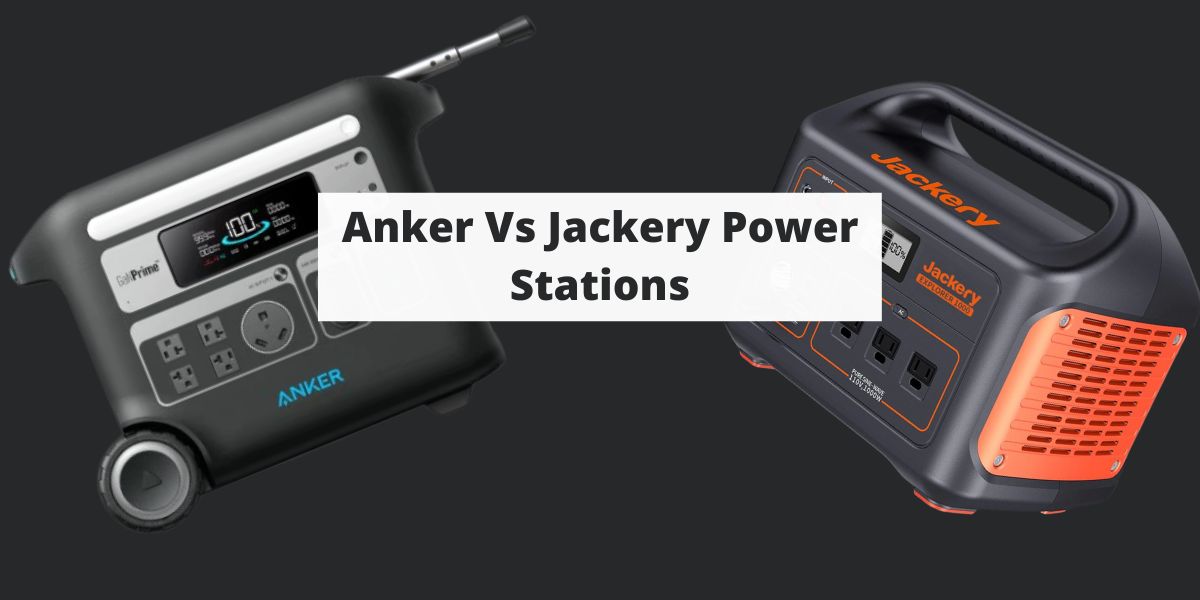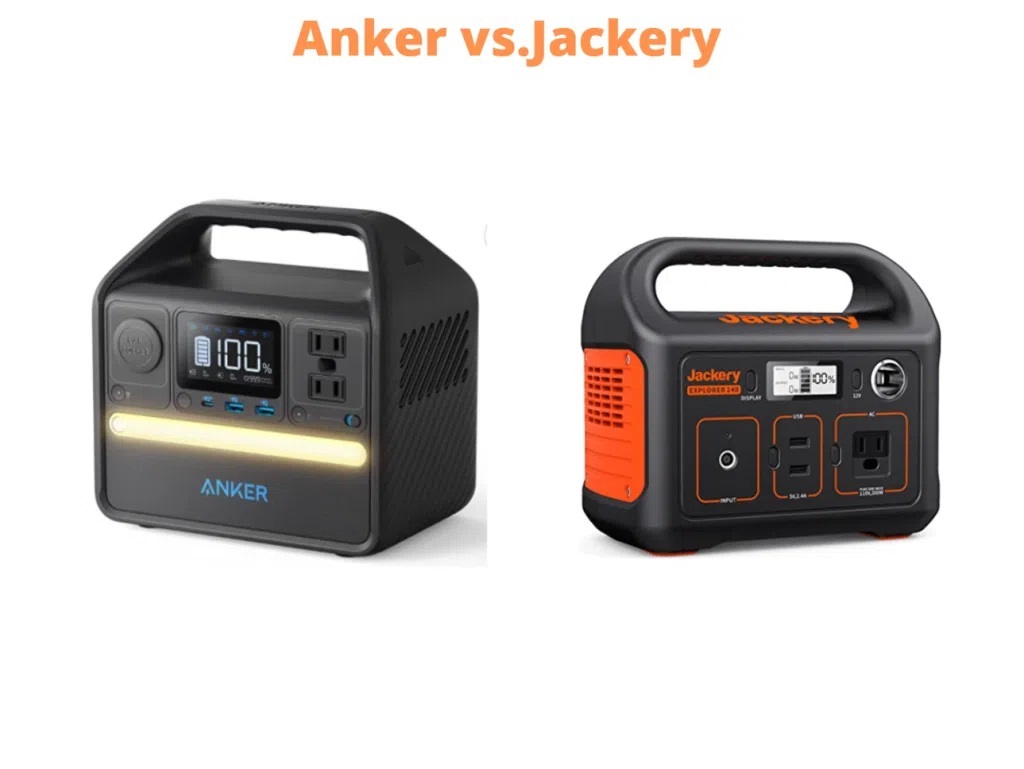
14 Feb Anker vs Jackery: How Do Their Portable Power Stations Stack Up?
Portable power stations are all the rage these days. As we increasingly rely on electronic devices in our daily lives, having a way to power them on the go has become a necessity. Two of the top brands in the portable power station game are Anker and Jackery. But which one is right for your needs? In this comparison guide, we’ll look at the key factors that differentiate Anker vs Jackery power stations to help you decide which is the best choice for you. We’ll compare features, performance, price, reliability and more.
So whether you’re looking for power on your next camping trip or emergency backup during a blackout, read on to see how Anker and Jackery stack up!
Difference: Anker Vs Jackery Power Station
| Specs | Anker | Jackery |
| Portability | Good | Better |
| Power Output | 200-1002Wh | 160-1500Wh |
| Charging Time | 4-10 hrs | 4-8 hrs |
| Power Sources | AC, Solar*, 12V, Generator | AC, Integrated Solar, 12V, Generator |
| Durability | Good | Good |
| Ease of Use | Better | Good |
| Price | $ – $$$ | $ – $$ |
| Connectivity | AC, USB, 12V | AC, USB, 12V, Extras |
| Reliability | Proven Brand | Industry Pioneer |
| Support | Excellent | Very Good |
Portability
Regarding portable power, size and weight are two of the most important considerations. You want something that packs enough power without being too bulky or heavy.
Both Anker and Jackery offer a range of power station sizes. Anker’s smallest is the PowerHouse 200, which weighs just under 5 pounds. Jackery’s equivalent is the Explorer 160, which weighs 4.3 pounds.
On the larger end, Anker has the 757 PowerHouse, while Jackery’s most significant model is the Explorer 1500. The Anker weighs almost 10 pounds more at 22.7 pounds versus 13.3 for the Jackery.
Winner: Jackery – While Anker has a slight edge on the low end for smallest/lightest, Jackery’s larger capacity power stations are markedly more portable.
Power Output
The whole point of a portable power station is to power your devices on the go, so output power capacity is one of the key factors to evaluate.
Anker’s power station capacities range from 200 watt-hours on the low end to a whopping 1002 watt-hours on their most significant model. Jackery’s range falls between 160 and 1500 watt-hours.
Both brands offer comparable outputs that run the gamut from small, medium, and large-capacity options. Most users’ needs will fall somewhere in the mid-range, which both companies provide similar specs.
Winner: Tie – There’s too much overlap in output capacities for a clear winner. Both provide flexible options to suit different usage needs.
Charging Time
How quickly a power station can recharge is often just as important as its output capacity. After all, you want to be able to top it back up efficiently to keep using it.
For smaller capacity models under 500 watt-hours, Anker and Jackery advertise recharge times of around 4-6 hours, given optimum conditions. However, some differences emerge once you move up to the larger stations.
According to their estimates, Anker’s 757 PowerHouse takes around 10 hours for a full recharge; the Jackery Explorer 1500, despite having a higher power output, claims recharge speeds of just 8 hours.
Winner: Jackery – While times are similar for smaller models, Jackery’s larger stations charge faster despite higher capacities.
Power Sources
Portable power stations aren’t much use unless you can get power into them. Both Anker and Jackery offer various recharging options for their models.
The standard included method is via an AC wall outlet, but you can also recharge using solar panels, your vehicle’s 12V outlet, or a generator.
Jackery has a slight edge in solar recharging. Their SolarSaga solar panels integrate seamlessly with their Explorer stations. Anker offers solar charging options, too, but the connection isn’t quite as smooth.
Winner: Jackery – Jackery’s integrated solar ecosystem gives them an advantage for eco-friendly charging off-grid.
Durability
Portable power stations need to withstand life on the go. A bump or jolt should not cause them to be out of commission. Durability is a must.
Both brands construct their stations from durable materials. Anker uses a combination of metals and tough plastics to protect the internal components. Jackery also relies on metal housings and molded plastic for maximum impact resistance.
User experiences reflect positively on both when it comes to durability. If you don’t throw them off a mountain, Anker and Jackery power stations will hold up well to regular use and travel.
Winner: Tie – There’s no clear winner for durability, as both seem engineered to take some bumps and bruises.
Ease of Use
Operating a portable power station should be simple and straightforward. You want intuitive controls and clear display feedback.
Anker takes home the win here. Reviewers praise the thoughtful design touches that make their power stations easy to use. The control buttons and digital displays offer excellent power levels and output feedback.
Jackery’s stations work well, too, but some users report that the displays can be small and more challenging to interpret at a glance. The controls are functional but not as elegantly designed.
Winner: Anker – Thoughtful design and user-friendly displays give Anker the edge for usability.
Price
Of course, price is a major factor for most buyers when comparing portable power stations. Both Anker and Jackery offer varied price points to suit different budgets.
Both offer entry-level models starting around $200 to $300 and going up from there. Mid-range options can range from $500 to $800. The heavy-duty 1500+ watt models exceed $1000.
Jackery tends to have lower retail prices across the board, slightly undercutting Anker. However, Anker runs frequent discounts and sales, which can make them the cheaper option on a given day.
Winner: Jackery – At retail value, Jackery stations are generally listed at lower prices, though deals can bring Anker down too.
Connectivity
The ability to power your devices is what makes a power station worthwhile. Connectivity options determine what you can actually plug in and use.
In this area, Anker and Jackery are nearly identical. Both offer a range of AC outlets, USB-A and USB-C ports, and 12-volt DC plugs. There are enough options to power anything from phones and laptops to mini-fridges and TVs.
The one difference is that Jackery offers a couple of models with added features like wireless charging support and RV outlets. But for most buyers, the standard ports will get the job done just fine.
Winner: Tie – Both provide various connectivity options to power up your devices. Jackery wins on versatility, but most people won’t need the extra features.
Brand Reputation & Reliability
When making any purchase, the brand’s reputation is an important consideration. You want to choose a known, trusted provider with a track record of reliability.
Anker and Jackery have established themselves as leaders in the portable power space. Jackery brought reusable power stations to market earlier, becoming an early category leader. Their expertise with solar generators gives them an edge.
But Anker is no newcomer, either. As a consumer brand, it is renowned for quality products and great support. Its power stations build on this reputation nicely.
Winner: Tie – Jackery pioneered this product category, but Anker also brings an exceptional reputation. Both are safe bets for reliability.
Customer Support
Customer support becomes vital if any issues arise with a portable power station. You want to know if help is available if needed.
Anker is renowned for its customer service. It provides 24/7 live support via phone, email, or chat. Warranty coverage is strong, too – 18 months for power stations. Their support reputation is sterling. If you’re grappling with the issue of very high CPU power usage, it’s crucial to explore efficient solutions; meanwhile, considering a switch to portable power sources like Jackery might offer relief, especially with their commitment to 24/7 support, solid warranty coverage, and overwhelmingly positive customer feedback, albeit slightly trailing behind Anker’s acclaim.
Winner: Anker. With exceptional service ratings across its product line, Anker edges out Jackery when it comes to helpful support.
Conclusion
So, when looking at the key factors, who comes out on top – Anker or Jackery?
Jackery has an edge with consistently lower retail pricing for portable power on a budget. Thanks to their integrated SolarSaga panel ecosystem, they also lead in solar-powered operation. And their large-capacity models edge out Anker for portability.
Anker, however, takes the cake when it comes to ease of use and customer support. Their thoughtful design and sterling service reputation give them added appeal for first-time power station buyers.
Ultimately, you can feel confident choosing either brand. Anker and Jackery make high-performing, reliable power stations suitable for various applications. It comes down to your priorities – convenience, connectivity, solar power, etc. – to decide which matches your needs.
Whichever you choose, keeping a portable power station at the ready can give you peace of mind to power through any situation. Safe travels on your adventures!
FAQs
Q: How long do Anker and Jackery power stations last on a single charge?
A: It depends on the capacity and power usage, but most can deliver 100-500 charging cycles. Smaller stations under 500Wh offer about 15-40 hours of use per charge, while larger 1,000Wh+ models can last 2-4 days.
Q: Can you bring a power station on an airplane?
A: Most airlines allow portable power stations under 30,000 mAh capacity on board. Larger units may need to be checked. Be sure to check your airline’s lithium battery rules. Always travel safely!
Q: What can a portable power station recharge?
A: Most can quickly recharge phones, tablets, laptops, cameras, small medical devices, drone batteries, and more. Higher-capacity models can even run mini-fridges, small TVs, electric grills, and CPAP machines. Just match your wattage needs.
Q: Do you need a power station with solar charging?
A: Not necessarily – you can always charge via an AC outlet and use solar panels with other stations. However, integrated solar recharging does provide added convenience for off-grid use. It depends if that’s worth the higher cost for your needs.
Q: Are Anker and Jackery power stations safe to use?
A: Yes, both brands meet essential safety standards. Their lithium-ion batteries feature protection against short circuits, overheating, overcharging, and more. As long as you follow the guidelines, power stations are very safe.




